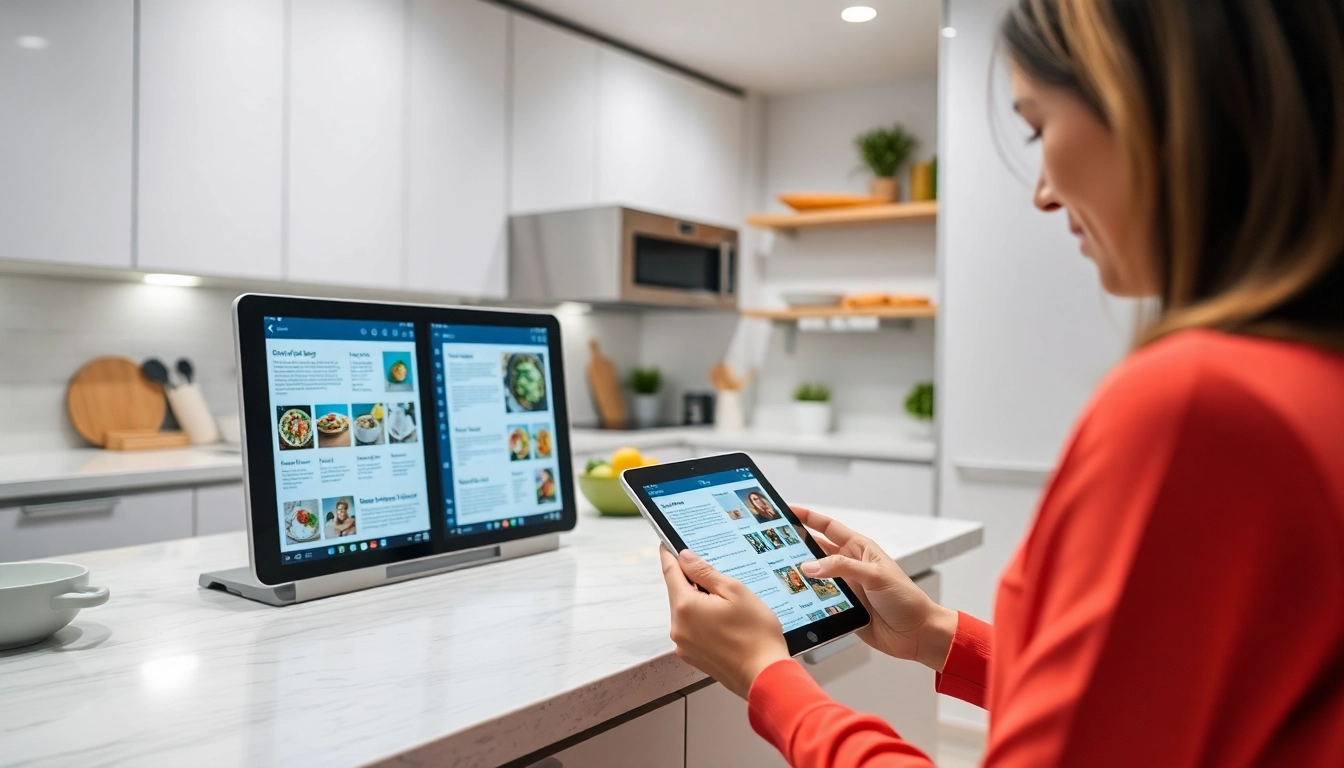Understanding the Importance of Digital Recipe Storage
In today’s fast-paced culinary world, keeping your favorite recipes organized and easily accessible is more crucial than ever. Traditional paper recipes, while nostalgic and charming, come with numerous limitations—including clutter, risk of damage, and difficulty in sharing. Transitioning to a best way to store recipes digitally offers a revolutionary approach that enhances efficiency, accessibility, and preservation. Digital storage solutions ensure your cherished culinary creations are protected from physical deterioration, clutter, and loss, while offering instant access across multiple devices.
Moreover, the digital method streamlines meal planning, shopping, and cooking processes. It transforms static handwritten recipes into dynamic, searchable, multimedia-rich resources adaptable to any lifestyle. As the culinary landscape evolves, understanding why and how digital storage can significantly elevate your cooking experience is essential for both amateur home cooks and professional chefs.
Benefits of Digital Over Paper Recipes
Convenience and Accessibility
Digital recipes can be accessed anytime and anywhere—on smartphones, tablets, laptops, or desktops. Whether you’re in your kitchen, at a grocery store, or on vacation, your recipe library travels with you. Cloud-based solutions such as Google Drive or specialized apps allow seamless synchronization across devices, eliminating the need for physical copies or manual transfers.
Enhanced Organization and Searchability
Digital platforms facilitate categorization by cuisine, meal type, ingredients, or dietary preferences. Advanced search functions enable quick retrieval by keywords, tags, or custom labels—saving significant time during meal prep. Some apps even allow tagging recipes with dietary info or seasonal tags, making meal planning more tailored and efficient.
Multimedia Integration
Unlike paper recipes, digital storage supports rich media embedding. Add high-quality photos, step-by-step videos, or voice notes to enrich your recipes. This multimedia approach not only makes recipes more engaging but also aids in understanding complex techniques or presentation styles.
Backing Up and Preserving Your Collection
Digital recipes are less susceptible to damage from spills, dirt, or aging. Regular backups—whether via cloud services or external drives—ensure you never lose your collection. This layer of security is vital for safeguarding long-term access and maintaining your culinary heritage.
Environmental Impact
Reducing reliance on paper not only declutters your kitchen but also contributes to environmental conservation. Digitizing recipes minimizes paper waste, aligning with sustainable and eco-friendly practices.
Common Challenges in Recipe Organization
Digital Overload and Clutter
With numerous apps and platforms available, users often face decision paralysis and clutter. Managing multiple tools without a cohesive system can lead to inefficiency and frustration.
Inconsistent Formatting and Data Entry
Importing recipes from various sources results in inconsistent formats, making search and categorization difficult. Transcribing handwritten recipes adds to the challenge if not done uniformly.
Security and Data Loss
Without proper backups, digital recipes are vulnerable to device failures, corruption, or hacking. Ensuring secure storage and regular backups is essential.
Learning Curve and Technical Skills
Some users may find digital tools intimidating initially, especially older generations accustomed to paper methods. User-friendly interfaces and tutorials can mitigate this challenge.
Cost and Subscription Fees
Premium apps or cloud services often come with costs, which can be a barrier for budget-conscious users. Balancing free and paid options requires careful evaluation.
Solution Strategies
- Choose an all-in-one platform that suits your needs to reduce clutter and streamline management.
- Develop a consistent routine for entering and updating recipes.
- Regularly back up your data on secure cloud services or external drives.
- Invest in user-friendly apps with good reviews and tutorials.
How Digital Storage Enhances Meal Planning
The digital organization of recipes transforms meal planning from a tedious task into an efficient process. By having all recipes neatly stored and tagged, you can quickly generate shopping lists or meal schedules. Many apps permit direct integration with grocery delivery services or shopping list generators, fostering a seamless cooking experience.
For example, selecting recipes with similar ingredients enables you to plan meals that minimize waste and reduce shopping trips. Digital collections also facilitate seasonal meal rotations and dietary adjustments, ensuring variety and nutritional balance.
Advanced features like calorie counting, nutritional analysis, or allergen filtering further elevate meal planning, especially for health-conscious or dietary-restricted individuals.
Popular Methods and Tools for Digital Recipe Storage
Top Apps and Platforms
Several specialized apps and platforms excel in recipe management. Recipe Keeper is renowned for its intuitive interface and multi-device compatibility, allowing users to import recipes via web scraping, photos, or manual entry. It also supports tags, categories, and sharing features.
Google Docs remains a versatile and free option, enabling users to create structured recipe documents with tables, images, and links. Its collaborative features allow sharing with family or friends, ensuring everyone stays updated.
Evernote provides a versatile workspace with note organization, multimedia support, and powerful search capabilities, making it ideal for those who want a flexible solution.
Cloud-Based Solutions for Seamless Access
Cloud services like Google Drive, Dropbox, or OneDrive empower users to access recipes across all devices with real-time synchronization. This approach reduces the risk of data loss and facilitates sharing with others.
Integrating Multimedia (Photos, Videos, Voice Notes)
Multimedia integration transforms static recipes into interactive cooking guides. Take high-quality photos of finished dishes or step-by-step process videos. Voice notes can be added to critical steps, making instructions clearer and more personal.
Many apps support importing media directly from devices or linking to cloud storage, enhancing the richness of your digital recipe collection.
Step-by-Step Guide to Organize Your Recipes Digitally
Digitizing Old Recipes: Scanning and Transcribing
Begin by gathering all handwritten, printed, or clipped recipes. Use a high-quality scanner or smartphone app (like Adobe Scan or Microsoft Office Lens) to digitize physical documents. Once scanned, clean up images with editing tools to ensure readability.
For recipes that are handwritten or in non-standard formats, transcribe them into a consistent digital template. Use clear headings, ingredients, steps, and notes to standardize the format across your collection.
Creating and Categorizing Digital Recipe Collections
Choose a central platform—be it an app, cloud folder, or document—and create broad categories like Appetizers, Main Courses, Desserts, Vegetarian, or Gluten-Free. Use tags such as ingredients, cuisine types, or difficulty levels for more granular organization.
Regularly update your categories as your collection grows, and consider creating subfolders or sub-tags for very detailed sorting.
Syncing and Backing Up Your Recipes Securely
Enable automatic synchronization with cloud services to keep your recipes updated across devices. Set up regular backup schedules, such as weekly exports to external drives or cloud storage, to prevent data loss.
Utilizing dedicated backup services or apps with autosync features ensures your collection remains safe and accessible long-term.
Optimizing Your Digital Recipe System for Maximum Efficiency
Tagging, Search Functions, and Custom Tags
Effective tagging is the cornerstone of a functioning digital recipe library. Assign multiple tags to each recipe—such as “Vegan,” “Quick,” “Italian,” or “Low Sugar”—to facilitate diverse search strategies. Use custom tags for personalized needs.
Leverage advanced search features, including Boolean operators or filter options, to rapidly pinpoint recipes fitting specific criteria. Consistent tagging practices prevent clutter and make retrieval effortless.
Sharing Recipes with Family and Friends
Many platforms support sharing via email, links, or direct app collaboration. Creating shared cookbooks or folders fosters communal cooking, recipe exchanges, and collective modifications.
Maintaining and Updating Your Digital Recipe Library
Set a routine for reviewing and updating recipes—removing outdated items, adding new discoveries, or refining instructions. Regular maintenance keeps your collection relevant, useful, and inspiring.
Performance Metrics and Tips to Ensure Long-term Success
Tracking Usage and Access Frequency
Use app analytics or manual logs to monitor which recipes are most accessed. This data helps identify your favorites and reveals gaps in your collection.
Gathering Feedback and Improving Organization
Engage family or friends to use your digital recipes and provide feedback. Adjust tags, categories, and interface based on their input to enhance usability.
Staying Ahead with New Digital Tools and Trends
Technology advances rapidly—new apps, AI-driven categorization, or voice-controlled interfaces emerge frequently. Staying informed through culinary blogs, tech reviews, and user communities ensures you leverage the latest innovations for ongoing recipe management improvements.









